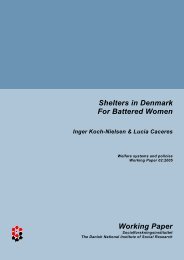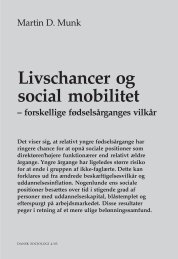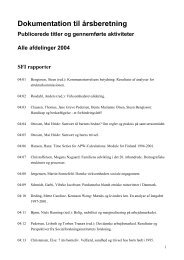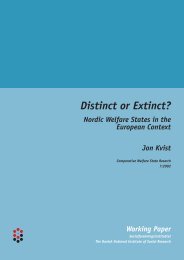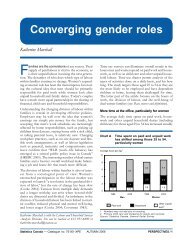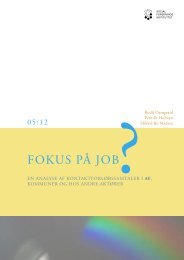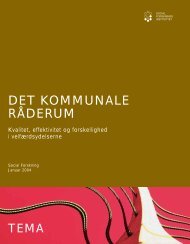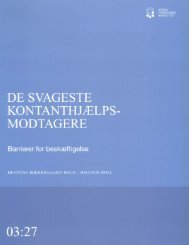Living Arrangements and Care Receipt Among Older People - SFI
Living Arrangements and Care Receipt Among Older People - SFI
Living Arrangements and Care Receipt Among Older People - SFI
Create successful ePaper yourself
Turn your PDF publications into a flip-book with our unique Google optimized e-Paper software.
DRAFT<br />
DO NOT CITE<br />
2003 CONFERENCE OF ESPANET, CHANGING EUROPEAN SOCIETIES –<br />
THE ROLE FOR SOCIAL POLICY<br />
SESSION SOCIAL POLICY AND AGEING CONVENORS AND CHAIRS:<br />
ANDREAS HOFF AND HANS-JOACHIM VON KONDRATOWITZ.<br />
LIVING ARRANGEMENTS AND CARE RECEIPT AMONG OLDER PEOPLE:<br />
AN OVERVIEW OF TRENDS<br />
Cecilia Tomassini, Karen Glaser, Emily Grundy<br />
Cecilia Tomassini, Office for National Statistics, Tel. +44-20-75335222<br />
Email: Cecilia.Tomassini@ons.gov.uk<br />
1. Background <strong>and</strong> purpose<br />
Population ageing has significant social <strong>and</strong> financial implications for families <strong>and</strong><br />
governments, <strong>and</strong> this has led to considerable interest in the future care needs of elderly<br />
people <strong>and</strong> the availability of family support. In addition, changes in patterns of family<br />
related behaviour <strong>and</strong> in the economic activity of women, have raised concerns regarding<br />
the future availability of family support for older people in need of assistance. For<br />
example, rises in female employment may reduce women’s ability to look after older<br />
relatives, especially in their own homes; <strong>and</strong> increases in childlessness may influence coresidence<br />
by reducing the pool of kin with whom older people can live. Although these<br />
trends are observable, to varying degrees throughout Europe, multigenerational<br />
households continue to remain much more common in Southern than in Northern Europe.<br />
Trends <strong>and</strong> determinants in the choice of living arrangements in later life have attracted a<br />
large research effort, but still differences between European (<strong>and</strong> other OECD) countries<br />
in indicators of intergenerational exchange, including living arrangements, are not fully<br />
understood. In this study we investigate trends in two measures of family support, living<br />
arrangements <strong>and</strong> receipt of care, <strong>and</strong> examine trends in cultural, socio-economic <strong>and</strong><br />
demographic factors across several countries participating in an European Scientific<br />
Foundation (ESF) network, ‘Family support for older people: determinants <strong>and</strong><br />
consequences’ (FAMSUP). Such a comparative analysis will provide a greater<br />
underst<strong>and</strong>ing of the relationship between different demographic regimes, cultural<br />
traditions, <strong>and</strong> policy contexts <strong>and</strong> family support for older people.<br />
2. Data <strong>and</strong> methods<br />
We use data from a variety of nationally representative data sources from several<br />
FAMSUP countries (Austria, Italy, Netherl<strong>and</strong>s, Portugal, Sweden, UK <strong>and</strong> U.S.), as well<br />
as data from OECD, Eurostat’s New Cronos database <strong>and</strong> the Eurobarometer Surveys.<br />
Demographic information is collected from: New Cronos, Council of Europe, Rowl<strong>and</strong><br />
1998, Santini 1974, US Census International DataBase, FAMSUP DataBase.<br />
Information on living arrangements <strong>and</strong> institutions is based on: Sündstrom (1994),<br />
FAMSUP DataBase, Iacovou 2000, OECD, special tabulations from national statistical<br />
institutes. Attitudinal data are from the Eurobarometer surveys (1993, 1998, 1999).<br />
Finally socio-economic indicators are based on the following sources: ILO, OECD,<br />
Eurostat ESSPROS, ECHP.
DRAFT<br />
DO NOT CITE<br />
3. <strong>Living</strong> arrangements<br />
3.1 <strong>Living</strong> <strong>Arrangements</strong> up to 1990: An Overview<br />
During the post-World War II period there has been a dramatic rise in the proportion of<br />
older people living alone in Europe, as well as in other industrialised countries (Kobrin,<br />
1976, Pampel, 1992, Sundström, 1994). This increase in the proportion of older people<br />
living alone has been accompanied by a general decline in the number of individuals<br />
living with relatives, particularly children, or non-related individuals (Grundy, 2000,<br />
Kobrin, 1976, Keilman, 1987, Murphy <strong>and</strong> Berrington, 1993, Wall, 1995, van Solinge,<br />
1994).<br />
While historically in Britain, for example, it was never common for married older people<br />
to live with their children, more elderly persons in pre-industrial times lived with a child<br />
than they do today (Wall, 1995). About forty percent of elderly men <strong>and</strong> one third of<br />
elderly women lived with a child in the pre-industrial communities studied by Wall<br />
(Wall, 1995). By contrast, never more than around 5% of men <strong>and</strong> 16% of women aged<br />
65 years <strong>and</strong> over lived alone (Wall, 1995). The percentage of elderly people living<br />
alone appears to have remained fairly constant until the 1960s, when it rose dramatically.<br />
Data from the ONS Longitudinal Study showed that between 1971 <strong>and</strong> 1991 the<br />
percentage of men aged 65 <strong>and</strong> over living alone increased from 13 to 19%, <strong>and</strong> for<br />
women from 34 to 43% (Grundy, 1996).<br />
Some of the changes responsible for this trend toward greater residential independence<br />
among elderly people, such as greater financial independence <strong>and</strong> possible improvements<br />
in health, are positive developments which may enable more older individuals to meet<br />
aspirations for ‘intimacy at a distance’ rather than having to co-reside with family<br />
members (Grundy, 1997, McGarry <strong>and</strong> Schoeni, 2000). There are, however, other factors<br />
which have also had an impact on the household composition of elderly people, such as<br />
low fertility rates among older cohorts, which have reduced the number of kin with<br />
whom older people can co-reside; increasing female employment, which may have<br />
reduced women’s willingness to look after older relatives, <strong>and</strong> rises in divorce <strong>and</strong> single<br />
motherhood, which may have weakened family ties <strong>and</strong> hence perceptions of felt<br />
obligation toward older relatives (Glaser, 1997).<br />
3.2 <strong>Living</strong> <strong>Arrangements</strong> 1990s: Recent Evidence<br />
This trend toward solitary living among the older population in Britain <strong>and</strong> other<br />
industrialised nations described above has been well established in the literature. Recent<br />
work in the U.S. <strong>and</strong> Italy, however, has shown a reversal of these earlier trends<br />
(Macunovich et al., 1995, Tomassini <strong>and</strong> Wolf, 2000a). This reversal has been attributed<br />
to the following factors: 1) rises in the proportions of older people living in a couple only<br />
household, due to both the increased survivorship of partners, <strong>and</strong> rises in the proportions<br />
married among the young elderly age groups; 2) increases in the availability of kin with<br />
whom older people may co-reside, a result of the ageing of the baby boomer’s parents;
DRAFT<br />
DO NOT CITE<br />
<strong>and</strong> 3) later ages at leaving the parental home among the younger generation, a result of<br />
longer periods of education, later marriage <strong>and</strong> a later stable working career.<br />
3.3 Trends in the living arrangements of elderly people in Britain <strong>and</strong> Italy<br />
Figure 1 shows trends over 30 years (i.e., 1970-2000) in living alone in Britain <strong>and</strong> Italy.<br />
In both countries there has been a slowdown in the trend toward solitary living. Table 1<br />
shows in greater detail the household composition of men <strong>and</strong> women aged 65 years <strong>and</strong><br />
over in Britain. In this table data from the General Household Survey (GHS) shows that<br />
the proportions of men living alone have stagnated in the 1990s, whereas the proportions<br />
living with a spouse have increased. In addition, the proportion of older individuals<br />
living with children or in ‘other’ types of households has declined. Trends for women are<br />
similar to those for men. Stagnation in the trend of older people living alone is also<br />
observed in Sweden <strong>and</strong> the Netherl<strong>and</strong>s (the latter country has experienced a<br />
considerable decline) (FAMSUP DataBase).<br />
Even though most European countries have experienced considerable rises in the<br />
proportion of older people living alone significant differences across countries remain<br />
with lower proportions of elderly individuals living in multigenerational households in<br />
Northern Europe when compared with their Southern European counterparts (Figure 2).<br />
3.4 Trends in the proportion of older people in communal establishments<br />
The proportion of older people resident in communal establishments, although low<br />
compared to other Northern European countries, has been fluctuating in Britain, for<br />
demographic reasons <strong>and</strong> as a result of government policy changes. At the 2001 Census<br />
4.1 per cent of people aged 65 <strong>and</strong> over were resident in communal establishments, a<br />
smaller proportion compared to the 5.1 per cent found in the 1991 Census. A similar<br />
decline occurred among people age 85 <strong>and</strong> older, with 18.1 per cent in 2001, against 23.4<br />
per cent found in 1991 (Figure 3). Women are more likely to live in institutions in old<br />
age: among women 65 <strong>and</strong> older, 5.4 per cent were resident in communal establishments,<br />
against just 2.4 per cent of men in the same age group. The differences are even more<br />
striking among very old people: 20.9 per cent of women older than 85, against 11.3 per<br />
cent of men, were living in communal establishments. An important factor for the higher<br />
presence of women in communal establishment is the different marital status<br />
composition: women are more likely to be widowed <strong>and</strong> so without a spouse to care for<br />
them. Another important factor is the higher level of disability reported by women at any<br />
given older age. Declines in institutionalisation among older people have also occurred<br />
in the Netherl<strong>and</strong>s <strong>and</strong> Sweden (FAMSUP DataBase). In Britain this follows an<br />
expansion in the use <strong>and</strong> provision of institutional care during the 1980s, an unintended<br />
consequence of policy changes which increased financial help available for those moving<br />
to residential <strong>and</strong> nursing homes. The policy response to this expansion was new<br />
legislation implemented in 1993 which was intended to reaffirm the objective of allowing<br />
older people to remain in their own homes as long as possible. Sweden, the Netherl<strong>and</strong>s<br />
<strong>and</strong> a number of other countries also now have explicit policy objectives to reduce<br />
institutional care use. Is the observed decline in institutionalisation a result of policy<br />
changes aimed a reducing the availability of institutional care or a result of the greater<br />
proportion of individuals with a surviving spouse in old age?
DRAFT<br />
DO NOT CITE<br />
4. Contacts with family members<br />
The notion of the familistic culture has been used in the past in order to explain strong<br />
family ties in Southern Europe (Banfield, 1958, Reher, 1998). In a familistic society,<br />
personal utility <strong>and</strong> family utility are the same: the structure of the family <strong>and</strong> the<br />
relationships among the family members are influenced by the strong ties that link them<br />
together. For example, intergenerational co-residence in Italy tends to continue until<br />
children leave the parental home to get married; <strong>and</strong> even then they normally live close to<br />
their parents (Dalla Zuanna, 2001). In Northern Europe there is a stronger individualistic<br />
culture, involving looser <strong>and</strong> less geographically close family ties, more emphasis on<br />
voluntaristic relationships (for example, recent research has shown that friends are<br />
becoming more important in older people’s ‘personal communities’: (Phillipson et al.,<br />
2001)) <strong>and</strong> greater preference for independent living. Figure 4 shows that 71% of elderly<br />
people in Italy reported daily contact with family members compared with only 14% in<br />
Denmark. There is less variation in the percentage of elderly people who report<br />
infrequent or no contact with family members <strong>and</strong> the proportions reporting loneliness<br />
appear, if anything to be inversely associated with the extent of contact (Figure 4). The<br />
same survey also found that the proportion of very isolated old people - those reporting<br />
few contacts with anyone - ranged from 2% in Nordic countries to 6% in Greece (Walker,<br />
1993). These apparently counter-intuitive findings are consistent with results from other<br />
studies which found high rates of loneliness among elderly people living with relatives<br />
<strong>and</strong> high rates of life satisfaction <strong>and</strong> self esteem among elderly people with networks of<br />
friends rather than, or as well as, networks of relatives (Wenger, 1984). Possibly too, in<br />
societies with high levels of family interaction, it is harder for those who lack such<br />
networks, whether from demographic mischance or choice, to forge <strong>and</strong> maintain<br />
alternative bonds (de Jong Gierveld <strong>and</strong> van Tilburg 1999).<br />
5. <strong>Receipt</strong> of care among older people<br />
The increase in the proportion of older people living alone has led to concerns regarding<br />
the future of family care for frail elderly relatives. In Britain, for example, although the<br />
needs of carers were explicitly recognised in the community care reforms in the 1990s<br />
(NHS <strong>and</strong> Community <strong>Care</strong> Act 1990, <strong>and</strong> the <strong>Care</strong>rs Recognition <strong>and</strong> Services Act<br />
1995), it remains unclear what impact these reforms have had on informal carers. In<br />
Britain, while the intention of the reforms was to address inadequate service provision,<br />
recent evidence shows a decline in the level of service support for those individuals who<br />
have an informal carer (Rowl<strong>and</strong>s, 1998). Nevertheless, only a small portion of care<br />
received by older people is provided by public social services in most industrial societies,<br />
the great majority of the care continues to be provided by family members including<br />
other elderly people, particularly spouses (Arber <strong>and</strong> Ginn, 1993, Walker, 1995). The<br />
norm of family care, however, may not be the ideal situation for either the caregiver or<br />
recipient. There is growing evidence to suggest that older people may prefer professional<br />
assistance in some circumstances, especially with tasks such as personal care (Daatl<strong>and</strong>,<br />
1990). In the 1997 British ONS Omnibus Survey, 40% of men <strong>and</strong> 33% of women aged<br />
65 years <strong>and</strong> over stated that they would prefer a mixture of family support <strong>and</strong><br />
professional care in their own home if in the future they were no longer able to manage
DRAFT<br />
DO NOT CITE<br />
on their own (Glaser et al., 1998). In addition, 28% of women <strong>and</strong> 23% of men aged 65<br />
<strong>and</strong> over stated that they would prefer the assistance of a only professional carer in their<br />
own home in such a situation (Glaser et al., 1998).<br />
Table 2 shows that, with the exception of Denmark, in most countries in the European<br />
Union (selected countries shown), the great majority of care received by older people is<br />
provided by family members. There is, however, considerable variation across countries,<br />
with a higher proportion of older people receiving care from family members in Southern<br />
European countries.<br />
6. Demographic trends<br />
6.1 Marital Status<br />
In the last three decades the proportion of married men <strong>and</strong> women aged 65 <strong>and</strong> over<br />
increased in almost all countries considered (Figure 5). The increase in the proportion of<br />
older married women from 1971 to 2001 has been small in some countries (Netherl<strong>and</strong>s,<br />
Sweden, Denmark <strong>and</strong> France), while it has been over 7 per cent in others (Spain, Italy,<br />
Portugal, Austria <strong>and</strong> Germany). The increase in the number of married men is less<br />
marked, <strong>and</strong> for some countries is negligible (e.g. for Sweden). It is useful to stress that<br />
changes in marital status of the older population are determined by demographic <strong>and</strong><br />
other factors. Improvements in life expectancy have resulted in an increase in the joint<br />
probability of spouses surviving together into old age. It is important to remember that<br />
for some countries divorce was not introduced until the 1970s (e.g., Italy <strong>and</strong> Portugal).<br />
Furthermore remarriage among the older people has increased: in 2001, among married<br />
people aged 50 <strong>and</strong> over in the UK, remarried persons represented 15.7 per cent of the<br />
total for men <strong>and</strong> 14.3 per cent for women. Additionally, a higher proportion of older<br />
cohorts never-married: for example, 12 per cent of English women born in 1910 nevermarried<br />
compared with only 5 per cent of those born in 1936 (Haskey, 1993).<br />
According to these trends the proportion of older women who have a spouse is higher<br />
today compared to 30 years ago, while for men it has not changed significantly. In the<br />
future we may expect a higher proportion of never-married persons, <strong>and</strong> a higher<br />
proportion of divorced people, even if remarriage is more common than in the past.<br />
6.2 Fertility<br />
In many Northern European countries (e.g., Belgium, Sweden, Germany <strong>and</strong> Engl<strong>and</strong> <strong>and</strong><br />
Wales) cohorts born in the 1920s <strong>and</strong> in the 1930s are characterised by lower fertility<br />
combined with higher levels of childlessness (Figure 6). In other countries the proportion<br />
of childless women has not varied greatly across cohorts, even if increases in the<br />
percentage of women without children is a common feature among Western European<br />
countries for those cohorts born after the 1950s. So very old people today may experience<br />
greater scarcity of support from children when compared with those cohorts born in the<br />
40s <strong>and</strong> 50s who experienced higher fertility levels.<br />
When the cohort fertility rate is considered, there is a similar trend across the countries:<br />
the rate dropped more dramatically in Portugal (from 3.0 to 1.9 children per woman for<br />
the cohorts born in 1930 <strong>and</strong> 1960 respectively) while it remained basically unchanged in
DRAFT<br />
DO NOT CITE<br />
Sweden (Figure 7). Numerous studies have shown that individuals with more children are<br />
less likely to live alone at older ages than those with fewer children (Mutchler, 1992,<br />
Wolf, 1994). In addition, kin availability has been demonstrated to be an important<br />
predictor of changes over time in the pattern of solitary living among older women<br />
(Wolf, 1995). The equation fewer children = increase in solitary living has been used as<br />
a basis for the concern in the future about the possible increase in the dem<strong>and</strong> for formal<br />
care services for frail older people lacking intra-household informal support. It is possible<br />
though that, despite a smaller number of children with whom the older parent can<br />
coreside, the outcome “living with children” may be achieved through different<br />
strategies. Declines in fertility may have an important effect on co-residence only if the<br />
number of childless women increases, as having one child may be sufficient for<br />
coresidence (Palloni, 2001). Furthermore fewer children may imply a smaller “crowding”<br />
effect behind decisions concerning leaving the parental home or children may receive<br />
more economic benefits in staying with their parents, postponing their decision to live<br />
independently. Parents may also invest more in their only child in order to keep him/her<br />
closer to them. A recent study in Italy showed that parental housing assistance played an<br />
important role in later life proximity between parents <strong>and</strong> children <strong>and</strong> the effect was<br />
mitigated when other children were available (Tomassini, 2003).<br />
If we consider the timing of fertility, again similar patterns occur across European<br />
countries. Recent cohorts show very similar mean ages at fertility of cohorts born in the<br />
1930s (Figure 8). This pattern shows how the mean generation length (i.e., difference<br />
between mother’s <strong>and</strong> child’s age) among older women will be similar to that<br />
experienced by generations born in the 1960s (even though these cohorts had fewer<br />
children). The timing of fertility (i.e., age of the mother at the last birth) determines to a<br />
large extent whether or not young adult children are still in the parental home when<br />
parents reach their 50s <strong>and</strong> 60s, although trends in home leaving are also important.<br />
Additionally later ages at childbirth may mean that adult children are still relatively<br />
“young” when their parents begin to experience poor health <strong>and</strong> disability.<br />
6.3 Female labour-force participation<br />
Rising female labour-force participation has led to concerns that increasing commitments<br />
outside the home will conflict with women’s ability <strong>and</strong> willingness to continue as<br />
important sources of care for elderly relatives, thereby potentially increasing the<br />
dependence of frail older people on state support (Dooghe, 1992). <strong>Among</strong> women aged<br />
45-60 in Northern European countries more than a half are economically active (88.2 per<br />
cent in Sweden <strong>and</strong> 76.9 in Denmark) with a similar, though slightly lower figure (55.4<br />
per cent) for Portugal (Figure 9). In addition, whilst the vast majority of employed<br />
women in this age group in Northern Europe are working part-time (77.8 in the<br />
Netherl<strong>and</strong>s <strong>and</strong> 47.5 per cent in the UK), the majority of employed women in Italy (84.8<br />
per cent) <strong>and</strong> in Portugal (79.7 per cent), even within this age range, are working fulltime<br />
(New Cronos).<br />
6.4 Life expectancy<br />
Lack of comparable health measures has been one of the key factors influencing the use<br />
of mortality indicators as proxies for the general well-being of older people. According to
DRAFT<br />
DO NOT CITE<br />
the most recent estimates life expectancy at age 65 ranges from 16.7 years in Denmark to<br />
20.9 years in Sweden, with Southern European countries in better shape than Northern<br />
European countries (both Spain, France <strong>and</strong> Italy have a value greater than 20 years)<br />
(New Cronos). In the 1970s instead, life expectancy at older ages was higher for Northern<br />
European countries.<br />
With regard to health, the European Community Household Panel collected information<br />
on several dimensions of health, including self-perceived health status; limitations in<br />
activities of daily living; any physical or mental health problem, illness or disability; cutdown<br />
in activities over the past two weeks because of health problems. These indicators<br />
have such different meanings for respondents in different European countries that they<br />
are unlikely to reflect real differences in health status but are more likely to reflect<br />
differences in attitudes to health or slight differences in question wording.<br />
7. Attitudinal trends<br />
Another interesting point raised in many studies about older people is different attitudes<br />
among family members toward the care of frail older people. According to the<br />
Eurobarometer survey, there is still a strong feeling of reciprocity <strong>and</strong> altruism among<br />
both young adults <strong>and</strong> older people: a third of the young people interviewed in the<br />
European Union think that that their generation has a responsibility towards older people<br />
<strong>and</strong> just 5% say that they would not like to have to take care of elderly relatives<br />
(European Commission 1997). Figure 10a <strong>and</strong> b shows the proportion of people aged 40<br />
<strong>and</strong> under <strong>and</strong> aged 40 to 64 who report that older people should go into a residential or<br />
nursing home when they are no longer able to manage on their own. Young Northern<br />
Europeans were more likely to consider the option of a residential or nursing home for<br />
frail older people (41% of the Swedes against just 2% of the Italians) (Figure 10 a <strong>and</strong> b).<br />
There has been little change in these attitudes over time (i.e., 1992-1999) <strong>and</strong> there are<br />
few differences between the generations (i.e., those aged 40 <strong>and</strong> under compared with<br />
those aged 40 to 64).<br />
Despite the common feeling of responsibility toward older people, younger generations<br />
have different ideas about the potential provision of assistance to their own frail elderly<br />
parents. Figure 11 shows that 73% of Spaniards <strong>and</strong> 51% of Italians would help their frail<br />
elderly parents by going to live with them compared with 34% of British <strong>and</strong> 10% of<br />
Danish children (Figure 11).<br />
8. Principle component analysis<br />
The aim of this analysis is to investigate how European countries are grouped according<br />
to the demographic, health, attitudinal measures used in this paper to describe the living<br />
conditions of older people. The idea is to synthesise the multidimensional space into a<br />
smaller one, in order to detect an underlying structure in the relationships between<br />
variables. The variables used in this analysis are:<br />
• demographic (proportion 65+ in 1970 <strong>and</strong> 2000, female life expectancy at 65 in 1970<br />
<strong>and</strong> 2000, childless in cohort 1930, TFR for cohort 1930, mean age at fertility for
DRAFT<br />
DO NOT CITE<br />
cohort 1930, % women 65+ married in 1970 <strong>and</strong> 2000, % women 65+ divorced in<br />
2000, % 65+ living alone in 1970s, % women living alone in 2000)<br />
• health (% 65+ with severe disabilities, % of 65+ in institution)<br />
• labour force participation (women 45-60 in LFS in 2000)<br />
• attitudinal (% 65+ with daily contacts with children, % people aged 45-64 that think<br />
that parents should move to a nursing home if they become frail, % of older people<br />
receiving family care only, % of older people receiving public care only)<br />
• policy <strong>and</strong> socio-economic context (expenditure on pensions as a % of GDP,<br />
expenditure on health care as a % of GDP, Women 65+ at risk of poverty - 60% of<br />
median equivalent income after social transfers)<br />
The first three components explain 75 per cent of the total variance, indicating a good<br />
synthesis of the matrix containing 22 variables <strong>and</strong> 12 countries. We used a VARIMAX<br />
rotation to better plot the results.<br />
The first factor, which explains 41 per cent of the total variance, is highly correlated with<br />
attitudinal characteristics, contrasting countries with a high proportion of family<br />
exchange (contacts <strong>and</strong> care) with those with high proportions of: adults who think that<br />
parents should go into institutions if they became frail; older people in institutions; <strong>and</strong><br />
older people receiving only formal care (Figure 12a). Additionally the first factor is<br />
positively correlated with high life expectancies in countries at age 65 in 1970 (i.e.,<br />
countries with better living conditions for older people in the 1970s).<br />
The second factor is characterised by past age structure (i.e., a high proportion of people<br />
aged 65 <strong>and</strong> over in 1970) <strong>and</strong> living arrangements (i.e., high levels of older people living<br />
alone in the 1970s <strong>and</strong> in the late 1990s) (Figure 12a).<br />
Figure 12b shows the countries’ position on the factorial plane that has the first factor on<br />
the x-axis <strong>and</strong> the second on the y-axis. As expected Sweden <strong>and</strong> Denmark are close<br />
together in the 1 st quadrant (the one characterised by a high proportion of: older people<br />
in institutions <strong>and</strong> receiving formal care; divorced older people; adults who think parents<br />
should go to institutions if they become frail; older people living alone in the past <strong>and</strong><br />
recently). Germany <strong>and</strong> Austria are in the 2 nd quadrant which is characterised by<br />
countries with relatively high proportions receiving family care <strong>and</strong> of GDP spent in<br />
health care. In the 3 rd quadrant we find Southern European countries <strong>and</strong> Irel<strong>and</strong> (even if<br />
the latter <strong>and</strong> Italy are weakly associated with the second factor), <strong>and</strong> in the 4 th we find<br />
the Netherl<strong>and</strong>s. The positions of Belgium <strong>and</strong> the U.K. (<strong>and</strong> France to a lesser extent) in<br />
this plane are not strongly defined, as these countries demonstrate an “average” level for<br />
the variables used in this analysis.<br />
9. Summary <strong>and</strong> Discussion<br />
Fertility declines responsible for population ageing have lead to concerns among policy<br />
makers that family support for older people may decline. However, changes in marital<br />
<strong>and</strong> family patterns do not always imply adverse consequences for family support. For<br />
example, Italy’s low fertility rate (a total fertility rate per woman of 1.24 compared with<br />
1.66 in Britain in 2003) does not appear to have led to a reduction in the availability of
DRAFT<br />
DO NOT CITE<br />
family care <strong>and</strong> support for older people (Tomassini <strong>and</strong> Wolf, 2000b). The factor<br />
analysis shows that “cultural” factors (in addition to “demographic” <strong>and</strong> “health <strong>and</strong><br />
welfare” factors) are one of the most important components explaining variance across<br />
the countries studied (these three factors explain close to 74% of the variance). However,<br />
there has been little change in attitudes over time according to Eurobarometer Survey<br />
data.
Fig.1 Proportion of women aged 65 plus living alone. 1970-2000<br />
DRAFT<br />
DO NOT CITE<br />
60<br />
55<br />
50<br />
45<br />
40<br />
35<br />
30<br />
25<br />
20<br />
1970 1975 1980 1985 1990 1995 2000<br />
I GB NL SWE<br />
Source: FAMSUP Database
DRAFT<br />
DO NOT CITE<br />
Table 1. Population aged 65+ by <strong>Living</strong> <strong>Arrangements</strong> <strong>and</strong> Sex, Britain (percentages)<br />
1980 a 1991 b 1998 c<br />
M W M W M W<br />
<strong>Living</strong> alone 17 45 24 47 24 47<br />
(one-person hhld)<br />
<strong>Living</strong> with partner 62 33 61 36 64 41<br />
only<br />
<strong>Living</strong> w off-spring 13 5 9 5 7 3<br />
<strong>and</strong> spouse*<br />
<strong>Living</strong> w off-spring 4 10 3 9 2 7<br />
but without spouse*<br />
Other arrangements + 4 6 2 4 2 2<br />
N 1842 2674 1580 2205 1337 1745<br />
* With or without other persons<br />
+ e.g. living with siblings, other relatives or non relatives<br />
Note: Off-spring is a child (biological, step or adopted) regardless of marital status.<br />
Sources: a ONS. GHS 1980 published tables, Table10.2; b Goodard, E., & Savage, D. (1994). <strong>People</strong> aged 65<br />
<strong>and</strong> over. London: HMSO, Table 4; c Bridgwood, A. (2000). <strong>People</strong> aged 65 <strong>and</strong> over. London: ONS, Table<br />
3.Table
Fig.2 <strong>Living</strong> arrangements of older people – ECHP 1994<br />
DRAFT<br />
DO NOT CITE<br />
Men<br />
100%<br />
80%<br />
60%<br />
40%<br />
20%<br />
0%<br />
DK NL UK I<br />
<strong>Living</strong> alone Just partner Partner <strong>and</strong> children other<br />
Women<br />
100%<br />
80%<br />
60%<br />
40%<br />
20%<br />
0%<br />
DK NL UK I<br />
<strong>Living</strong> alone Just partner Partner <strong>and</strong> children other<br />
Source: Iacovou 2000
DRAFT<br />
DO NOT CITE<br />
Figure 3: Proportion of people aged 85plus resident in communal establishment in<br />
Britain, Netherl<strong>and</strong>s <strong>and</strong> Sweden by gender, 1991 <strong>and</strong> 2001<br />
50<br />
40<br />
%<br />
30<br />
20<br />
10<br />
0<br />
Women Men Women Men Women Men<br />
GB NL SWE<br />
1990/91 2000/01<br />
Note: For Great Britain a resident in communal establishment is any person who has been living, or intends<br />
to live, in the establishment for six months or more. It excludes visitors <strong>and</strong> staff family members. <strong>People</strong><br />
visiting the establishment on Census day who do not have a usual address elsewhere are also classified as a<br />
resident.<br />
Sources: For Great Britain 1991 <strong>and</strong> 2001 Censuses
DRAFT<br />
DO NOT CITE<br />
Fig.4 Contacts with family <strong>and</strong> reported loneliness among people aged 65+<br />
80<br />
70<br />
60<br />
50<br />
40<br />
30<br />
20<br />
10<br />
0<br />
Italy Great Britain Denmark Netherl<strong>and</strong>s<br />
Daily contacts Contacts less than monthly Often feel lonely<br />
Source: (Eurobarometer 37.2 1992)
DRAFT<br />
DO NOT CITE<br />
Table 2: ‘Who gives you regular help or assistance?’ <strong>Among</strong> respondents who get<br />
regular help or assistance with personal care or household tasks because they find it<br />
difficult to do these by themselves,<br />
Persons aged 65 <strong>and</strong> over<br />
GENDER AND DENMARK GREAT NETHERLANDS ITALY PORTUGAL<br />
WHO RECEIVE<br />
BRITAIN<br />
HELP FROM<br />
Family only 21.2 53.2 29.4 77.2 86.1<br />
Public social 40.4 14.0 21.9 1.7 2.5<br />
service only<br />
Other 38.4 32.8 48.7 21.2 11.5<br />
N 103 97 152 109 189<br />
Source: 1992 Eurobarometer 37.2
Fig.5 Changes in marital status distribution over time – Women 65+<br />
DRAFT<br />
DO NOT CITE<br />
Single Widowed Divorced/separated Married<br />
100%<br />
90%<br />
80%<br />
70%<br />
60%<br />
50%<br />
40%<br />
30%<br />
20%<br />
10%<br />
0%<br />
71 91 01 70 90 00 75 90 00 71 91 01<br />
Italy Netherl<strong>and</strong>s Sweden UK<br />
Source: FAMSUP Database
Fig.6 Proportion of childless women by cohort<br />
DRAFT<br />
DO NOT CITE<br />
20<br />
16<br />
12<br />
%<br />
8<br />
4<br />
0<br />
1930 1932 1934 1936 1938 1940 1942 1944 1946 1948 1950 1952 1954 1956 1958 1960<br />
Cohort<br />
Italy Netherl<strong>and</strong>s Portugal Sweden Engl<strong>and</strong>&Wales<br />
Source: New Cronos
Fig.7 Cohort Total Fertility Rate<br />
DRAFT<br />
DO NOT CITE<br />
3.2<br />
2.8<br />
2.4<br />
2<br />
1.6<br />
1930 1935 1940 1945 1950 1955 1960<br />
Italy Netherl<strong>and</strong>s Portugal Sweden Engl<strong>and</strong> & Wales<br />
Source: New Cronos
Fig. 8 Mean age at fertility by cohort<br />
DRAFT<br />
DO NOT CITE<br />
30<br />
29<br />
28<br />
27<br />
26<br />
25<br />
1930 1932 1934 1936 1938 1940 1942 1944 1946 1948 1950 1952 1954 1956 1958 1960 1962<br />
D I NL A PT SWE E&W<br />
Source: New Cronos
Fig. 9 Trends in women’s labour force participation (women aged 40-64)<br />
DRAFT<br />
DO NOT CITE<br />
90<br />
80<br />
70<br />
60<br />
50<br />
40<br />
30<br />
20<br />
10<br />
1950 1960 1970 1980 1990 2000 2010<br />
Austria Germany Italy Netherl<strong>and</strong>s Portugal Sweden<br />
Source: ILO
DRAFT<br />
DO NOT CITE<br />
Fig.10 a Proportion of people younger than 40 thinking that older people should go to<br />
residential/nursing homes<br />
25<br />
20<br />
15<br />
10<br />
5<br />
0<br />
DK S NL GB I<br />
1992 1999<br />
Fig.10 b Proportion of people aged 40-64 thinking that older people should go to<br />
residential/nursing homes<br />
25<br />
20<br />
15<br />
10<br />
5<br />
0<br />
DK S NL GB I<br />
1992 1999
DRAFT<br />
DO NOT CITE<br />
Fig. 11 “How to help a frail parent who can no longer manage alone?” Respondents aged<br />
40-64<br />
100%<br />
80%<br />
60%<br />
40%<br />
20%<br />
0%<br />
SWE NL GB I<br />
Parent should move to a child's hoouse<br />
A child should move to the parent's house<br />
One should move closer to the other<br />
Parent should move to nursing home<br />
Parent should stay at home, <strong>and</strong> receive visits It depends/DK<br />
Source: Eurobarometer 1998
Fig. 12a<br />
DRAFT<br />
DO NOT CITE<br />
Source: FAMSUP Database
Fig 12 b<br />
DRAFT<br />
DO NOT CITE<br />
Source: FAMSUP DataBase
DRAFT<br />
DO NOT CITE<br />
References<br />
Arber, S. <strong>and</strong> Ginn, J. 1993, 'Gender <strong>and</strong> inequalities in health in later life', Social Science<br />
<strong>and</strong> Medicine, vol. 36, pp. 33-46.<br />
Banfield, E. 1958. The moral basis of a backward society: Glencoe.<br />
Daatl<strong>and</strong>, S. O. 1990, 'What are families for? On family solidarity <strong>and</strong> preference for<br />
help', Ageing <strong>and</strong> Society, vol. 10, pp. 1-15.<br />
Dalla Zuanna, G. 2001, 'The banquet of Aeolus: a familistic interpretation of Italy's<br />
lowest low fertility', Demographic Research, vol. 4, pp. 133-61.<br />
de Jong Gierveld, J.<strong>and</strong> T. van Tilburg. 1999. "<strong>Living</strong> arrangements of older adults in the<br />
Netherl<strong>and</strong>s <strong>and</strong> Italy: Coresidence values <strong>and</strong> behaviour <strong>and</strong> their consequences<br />
for loneliness." Journal of Cross-Cultural Gerontology 14(1):1-24.<br />
Dooghe, G. 1992, 'Informal caregivers of elderly people: An European review', Ageing<br />
<strong>and</strong> Society, vol. 12, pp. 369-380.<br />
Glaser, K. 1997, 'The living arrangements of elderly people', Reviews in Clinical<br />
Gerontology, vol. 7, pp. 63-72.<br />
Glaser, K., Hancock, R. <strong>and</strong> Stuchbury, R. 1998, Attitudes in an ageing society, Research<br />
sponsored by Age Concern Engl<strong>and</strong> for the Millennium Debate of the Age, Age<br />
Concern Institute of Gerontology, London.<br />
Grundy, E. 1996, 'Population Review: (5) The population aged 60 <strong>and</strong> over', Population<br />
Trends, vol. 84, pp. 14-20.<br />
Grundy, E. 1997, 'The health <strong>and</strong> health care of older adults in Engl<strong>and</strong> <strong>and</strong> Wales, 1841-<br />
1994', in The Health of Adult Britain 1841-1994, eds J. C. Charlton <strong>and</strong> M.<br />
Murphy, The Stationery Office, London, pp. 182-203.<br />
Grundy, E. 2000, 'Co-residence of mid-life children with their elderly parents in Engl<strong>and</strong><br />
<strong>and</strong> Wales: Changes between 1981 <strong>and</strong> 1991', Population Studies, vol. 54, pp.<br />
193-206.<br />
Haskey, J. 1993, 'First marriage, divorce, <strong>and</strong> remarriage: birth cohort analyses',<br />
Population Trends, vol. 72, pp. 24-33.<br />
Iacovou, M. 2000, The living arrangements of elderly Europeans, EPAG Working Paper<br />
9, Institute for Social <strong>and</strong> Economic Research (ISER). University of Essex.<br />
Keilman, N. 1987, 'Recent trends in family <strong>and</strong> household composition in Europe',<br />
European Journal of Population, vol. 3, pp. 297-325.<br />
Kobrin, F. E. 1976, 'The primary individual <strong>and</strong> the family: Changes in living<br />
arrangements in the United States since 1940', Journal of Marriage <strong>and</strong> the<br />
Family, vol. 38, pp. 233-239.<br />
Macunovich, D. J., Easterlin, R. A., Schaeffer, C. M. <strong>and</strong> Crimmins, E. M. 1995, 'Echoes<br />
of the baby boom <strong>and</strong> bust: Recent <strong>and</strong> prospective changes in living alone<br />
among elderly widows in the United States', Demography, vol. 32, pp. 17-28.<br />
McGarry, K. <strong>and</strong> Schoeni, R. 2000, 'Social security, economic growth, <strong>and</strong> the rise in the<br />
elderly widow's independence in the twentieth century', Demography, vol. 37, pp.<br />
221-236.<br />
Murphy, M. <strong>and</strong> Berrington, A. 1993, 'Household change in the 1980s: a review',<br />
Population Trends, vol. 73, pp. 18-26.<br />
Mutchler, J. E. 1992, '<strong>Living</strong> arrangements <strong>and</strong> household transitions among the<br />
unmarried in later life', Social Science Quarterly, vol. 73, pp. 565-580.
DRAFT<br />
DO NOT CITE<br />
Palloni, A. 2001, '<strong>Living</strong> arrangements of older persons', in <strong>Living</strong> arrangements of older<br />
persons: Critical issues <strong>and</strong> policy responses, ed U. Nations, United Nations,<br />
New York.<br />
Pampel, F. C. 1992, 'Trends in living alone among the elderly in Europe', in Elderly<br />
migration <strong>and</strong> population redistribution: A comparative study, ed A. Rogers,<br />
Belhaven Press, London, pp. 97-117.<br />
Phillipson, C., Bernard, M., Phillips, J. <strong>and</strong> Ogg, J. (eds.) 2001, The Family <strong>and</strong><br />
Community Life of <strong>Older</strong> <strong>People</strong>, Routledge, London.<br />
Reher, D. 1998, 'Family ties in Western Europe: Persistent contrasts', Population <strong>and</strong><br />
Development Review, vol. 24, pp. 203-234.<br />
Rowl<strong>and</strong>, D. T. 1998, Cross-National Trends in Childlessness, Working Papers in<br />
Demography, No. 73, The Australian National University, Canberra.<br />
Rowl<strong>and</strong>s, O. 1998, Informal <strong>Care</strong>rs, The Stationery Office, London.<br />
Santini, A. 1974, La fecondità delle coorti- Studio longitudinale della fecondità italiana<br />
dagli inizi del secolo XX, Firenze, Firenze Dip. Statistica e Matematica.<br />
Sundström, G. 1994, '<strong>Care</strong> by families: An overview of trends', in Caring for frail<br />
elderly people. New directions in care, ed OECD, OECD Social Policy Studies,<br />
Paris, pp. 15-55.<br />
Tomassini, C. <strong>and</strong> Wolf, D. 2000a, 'Stability <strong>and</strong> change in the living arrangements of<br />
older Italian women: 1990-1995', Genus, vol. LVI, pp. 203-219.<br />
Tomassini, C. <strong>and</strong> Wolf, D. A. 2000b, 'Shrinking kin networks in Italy due to sustained<br />
low fertility.', European Journal of Population Studies, vol. 16, pp. 353-372.<br />
Tomassini, C., D.A. Wolf, <strong>and</strong> A. Rosina. 2003. "Parental housing assistance <strong>and</strong> parentchild<br />
proximity in Italy." Journal of Marriage <strong>and</strong> the Family 65(3), pp 700-715.<br />
van Solinge, H. 1994, '<strong>Living</strong> arrangements of non-married elderly people in the<br />
Netherl<strong>and</strong>s in 1990', Ageing <strong>and</strong> Society, vol. 14, pp. 219-236.<br />
Walker 1993, Age <strong>and</strong> attitudes: Main results from a Eurobarometer survey,<br />
Commission of the European Communities, Brussels.<br />
Walker, A. 1995, 'The family <strong>and</strong> the mixed economy of care - can they be integrated?',<br />
in The Future of Family <strong>Care</strong> for <strong>Older</strong> <strong>People</strong>, eds I. Allen <strong>and</strong> E. Perkins,<br />
HMSO, London, pp. 201-220.<br />
Wall, R. 1995, 'Elderly persons <strong>and</strong> members of their households in Engl<strong>and</strong> <strong>and</strong> Wales<br />
from preindustrial times to the present', in Aging in the Past, eds D. I. Kertzer <strong>and</strong><br />
P. Laslett, University of California Press, Berkeley, pp. 81-106.<br />
Wenger, G. C. 1984, The Supportive Network: Coping with Old Age, George Allen <strong>and</strong><br />
Unwin, London.<br />
Wolf, D. A. 1995, 'Changes in the living arrangements of older women: an international<br />
study', The Gerontologist, vol. 35, pp. 724-731.



